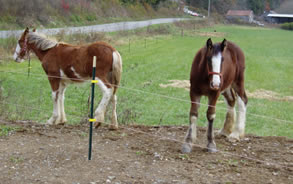
Permanent Horse Fencing
If the fencing is to be permanent then it's best to have a wooden posts sunk into the ground and insulators attached to hold the conductor in place. The insulators prevent the current from earthing out and can be offset from the fence in necessary. For most permanent perimeter fencing, we'd recommend a 40mm diameter tape except in exposed areas where we'd recommend 20mm tape or a rope. The reason being that 40mm tape can sometimes catch the wind and flap causing damage to itself.
The height, spacings and number of conductors depend largely upon the horse being contained. the more spirited the horse, the more lines of electric fencing you'll need. For all horses, a conductor at nose level is ideal as this will always be a reminder of the fence and once the horse has touched the electric fence, the barrier becomes not so much physical as phsycological. The line around the 1m mark is really a backup to the higher line and it can prevent the horse from stretching under the main line. The additional visual presence only adds to the horses respect of the fenceline.
Temporary Horse Fencing
Polyposts and tape or rope should be used here. One or two lines should deter the horse and the polyposts are very easily moved. For most horses, the 105cm posts are perfectly adaquate and are fine for strip grazing but for larger horses, the tall posts give that extra element of security.

